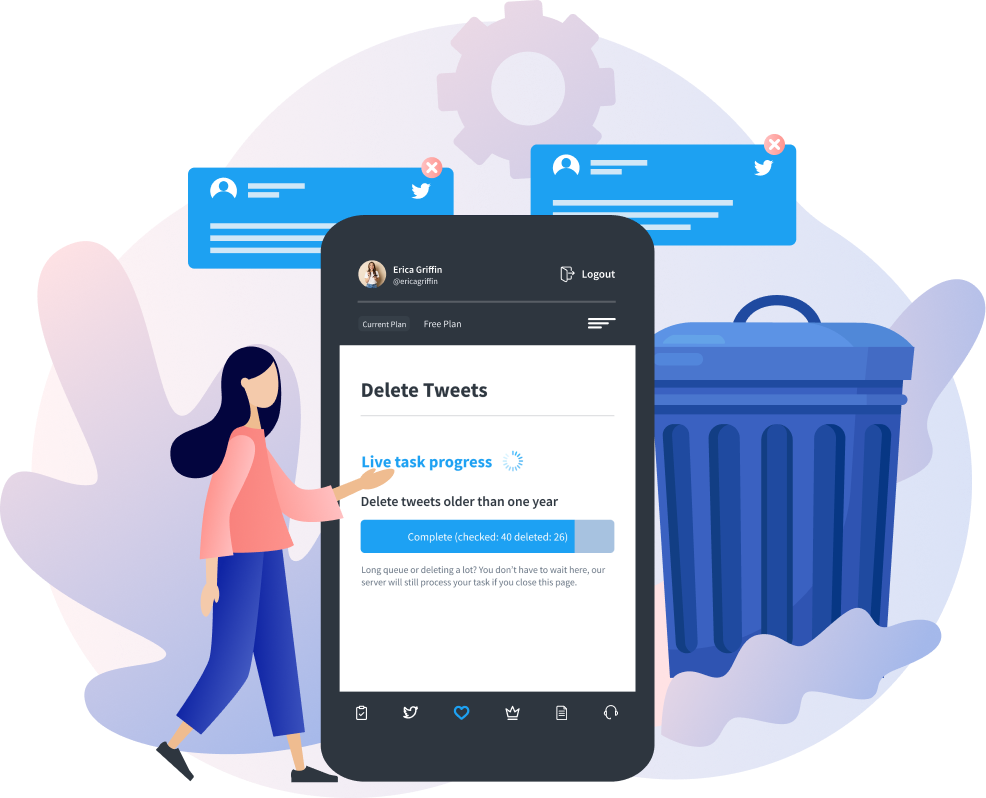The API on Twitter is a powerful tool for accessing Twitter’s massive data stream. It provides access to public tweets, likes, retweets, profiles, etc., enabling you to build or improve projects with that data.
Learning about the X API saves time and resources, especially for developers looking to build projects with Twitter data. Read this article to learn everything you need to know about Twitter API, such as the various tiers and use cases.

What Is API on Twitter?
The Twitter API is a framework that allows developers to interact with Twitter’s data. But what is API on Twitter, and how does it work? It essentially provides a means to get tweets, user profiles, and other public information from Twitter.
The Twitter API is not an app itself. It’s more like a set of rules and tools that guide you in accessing data from the system.
Twitter currently offers four main API tiers. API tiers are the different levels of access a user can have to the system. Each tier differs in terms of the number of requests per month, features, data access, etc. Below are the four tiers Twitter API offers.
Free Tier
The free tier allows you to pull tweets and user profiles and perform small-scale analyses. It also allows developers to make up to 1500 requests per month.
The Free tier is great if you’re building lightweight projects for a hobby or a small research task. However, it has some limitations. For example, you can’t access old tweets past a certain period or detailed data for more in-depth analysis.
Basic Tier
The Basic tier, priced at $100 monthly, offers 3,000 post requests and 10,000 pull requests. These capabilities exceed the Free tier’s limits but at some cost. The Basic tier also includes access to the X API v2 and standard v1.1 endpoints for media upload, help, etc.
This tier supports filtered stream API but does not offer access to the full-archive search. Developers can manage one project and up to two apps within that project. The Basic Tier is for large applications that require more data and higher request limits.
Pro Tier
At $5000 monthly, the Pro Tier significantly upgrades your capabilities. It allows 300,000 posts and 1,000,000 pull requests per month, giving you plenty of data access. This tier supports the filtered stream API and full-archive search, providing a broad range of data collection options.
You also get access to X API v2 and standard v1.1 endpoints for media uploads, rate limits, etc. Developers can manage one project with up to three apps. Pro Tier is perfect for large-scale applications that require large data and fast access.
Enterprise Tier
With custom pricing, the Enterprise Tier offers the most advanced access and features available. You’ll have access to unlimited posts and pull requests, along with the filtered stream API and full-archive search.
Of course, developers also benefit from full access to both X API v2 and standard v1.1 endpoints. This tier offers the highest level of customization and scalability, making it ideal for large organizations or high-demand projects.
With the Enterprise tier, you can create an unlimited number of projects and apps. It is for large-scale applications that require extensive data analysis and high-volume requests. However, it is important to note that it comes at a higher cost compared to other tiers.

How To Get Started on Using the Twitter API
Getting started using the X API isn’t that difficult; however, there are some guidelines you need to follow. First, you must sign up for a developer account on the X Developer platform.
You’ll get an API key and access token. These details will enable you to make requests to the X API endpoints. Let’s delve deeper into this process below.
1. Sign Up for a Developer Account
Signing up for a developer account on the X Developer platform is simple. All you have to do is go to the X Developer portal and create a developer account by providing your email and other necessary details
2. Create a Project
Follow this procedure to create a project on the X Developer Platform:
- Navigate to the Projects section.
- Create a new project and give it a name.
- Within your project, create a new App to hold your API credentials
3. Obtain API Keys
To obtain your API keys, access your newly created app to view your API key, API secret key, and Bearer Token. Then copy and store these credentials securely, as you will need them for authentication.
4. Make an API Request
The procedure below will enable you to make your first API request:
- Input your Bearer Token in the request header to authenticate your API call.
- Select the correct URL based on the API endpoint you want to use.
- Depending on the API endpoint, add any necessary parameters to your request (e.g., user ID, tweet ID, search query).
- Use your programming language’s HTTP library to send the request to the X API endpoint.
How To Check Remaining API on Twitter
Each Twitter API tier is subject to a rate limit. Rate limits restrict the number of API calls within a certain period. Basically, they prevent you from overwhelming Twitter’s servers with too many requests.
It’s important to note that exceeding your rate limit can result in temporary or permanent restrictions on your API access. Hence, by knowing your remaining calls, you can effectively plan your usage to ensure smooth operation.
Here is how to check the remaining API on Twitter:
- Log in to your Twitter Developer account: Visit the developer portal and enter your credentials.
- Navigate to the API Reference: Look for the “API Reference” section. You’ll find detailed information about the available API endpoints and their usage limits.
Find your rate limit information: Look for the specific API endpoint you’re using and check its rate limit information. This action will typically show the number of requests you can make within a given time frame.

How To Create and Manage Ads on Twitter API
Utilizing data from Twitter to launch ads or marketing campaigns on the app is a game changer. Businesses use this X marketing strategy to target their ads to the right audience to gain exposure and sales.
Using Twitter Analytics and the Twitter API, companies can better understand user behavior and engagement patterns on the app. This advantage will help them fine-tune their campaigns and ensure that ads reach their target audience more effectively.
Twitter’s API automates the process of continuously tracking performance metrics and adjusting strategies to optimize ad campaigns. However, setting up the process to create and manage ads on Twitter API might be technical.
Below is a step-by-step guide for you to follow.
1. Set Up Your Twitter Ads Account
Here is how to set up your Twitter ads account on the platform:
- Create a Twitter Ads account if you don’t already have one.
- Link your Twitter Ads account to your main Twitter account.
2. Obtain API Credentials
Below is the procedure to follow to obtain your credentials on the platform:
- Generate the API keys and access tokens from the Twitter Developer Portal.
- Ensure you have the necessary permissions to create and manage ads.
3. Create Ad Groups and Ads
The next steps involve creating an ad group to store and manage your ads:
- Use the Twitter Ads API to create ad groups and individual ads within those groups.
- Define targeting parameters, such as audience demographics, interests, and behaviors.
- Set your budget and bidding strategy.
4. Optimize Your Ads
Follow the steps below to optimize your ads for wider reach:
- Track the performance of your ads using the Twitter Ads API.
- Analyze metrics like impressions, clicks, conversions, and cost per acquisition.
- Adjust your targeting, bidding, and creative elements to improve results.
5. Manage Your Campaign
Here are some tips on managing your ad campaigns:
- Pause or stop underperforming ads.
- Allocate more budget to high-performing ads.
- Test different ad variations to identify the most effective ones.

How To Share on Twitter API
Posting content directly to your Twitter account from a separate platform is possible. This functionality allows you to automate content sharing, schedule tweets, and more. Below are the steps on how to share on Twitter API.
1. Get API Credentials
Follow the steps below to get your API credentials:
- Create a Twitter developer account.
- Generate API keys, including consumer key, consumer secret, access token, and access token secret.
- Ensure you have the necessary permissions to post tweets.
2. Construct and Share the Request
The steps below will guide you on how to construct and share your request to Twitter’s API:
- Choose the appropriate endpoint for sharing content. The most common endpoint for posting tweets is /2/tweets.
- Prepare the request body with the content, including text, photos, videos, etc.
- Include your API credentials in the request headers using OAuth 2.0 authentication.
- Send your request to the Twitter API endpoint.
FAQ
FAQ: How do I access the Twitter API?
First, sign up for a Twitter Developer account. Then, create a new app and get your API keys from the developer portal. These keys are your ticket to accessing Twitter’s data.
FAQ: What are the rate limits for the Twitter API?
Twitter limits the number of times anyone can use the API for a specific time, usually 15 minutes. The specific rate limits for the Twitter API vary depending on the API endpoint and your API tier.
How much does it cost to use the Twitter API?
The Twitter API has different tiers. There is a free one, a basic one that costs $100 per month, a Pro tier that comes at $5000 per month, and an Enterprise tier that has varying costs.
Streamline Your Twitter Data Project With TweetEraser
You’ll need large amounts of data when using Twitter data for projects like tracking trends or analyzing user behavior. The API on Twitter gives you access to this data, but not all may be useful for your project.
Old tweets past a period might be useless, crowding your dataset and making it harder to focus on newer insights.
This problem is where TweetEraser shines. It lets you bulk delete tweets based on filters like keywords or dates. Our other services include deleting retweets, likes, or entire Twitter histories with one click.
Ready to give TweetEraser a try? Simply sign in with your X account, set up your account, and begin deleting tweets. Use TweetEraser now and clean up your Twitter timeline!





